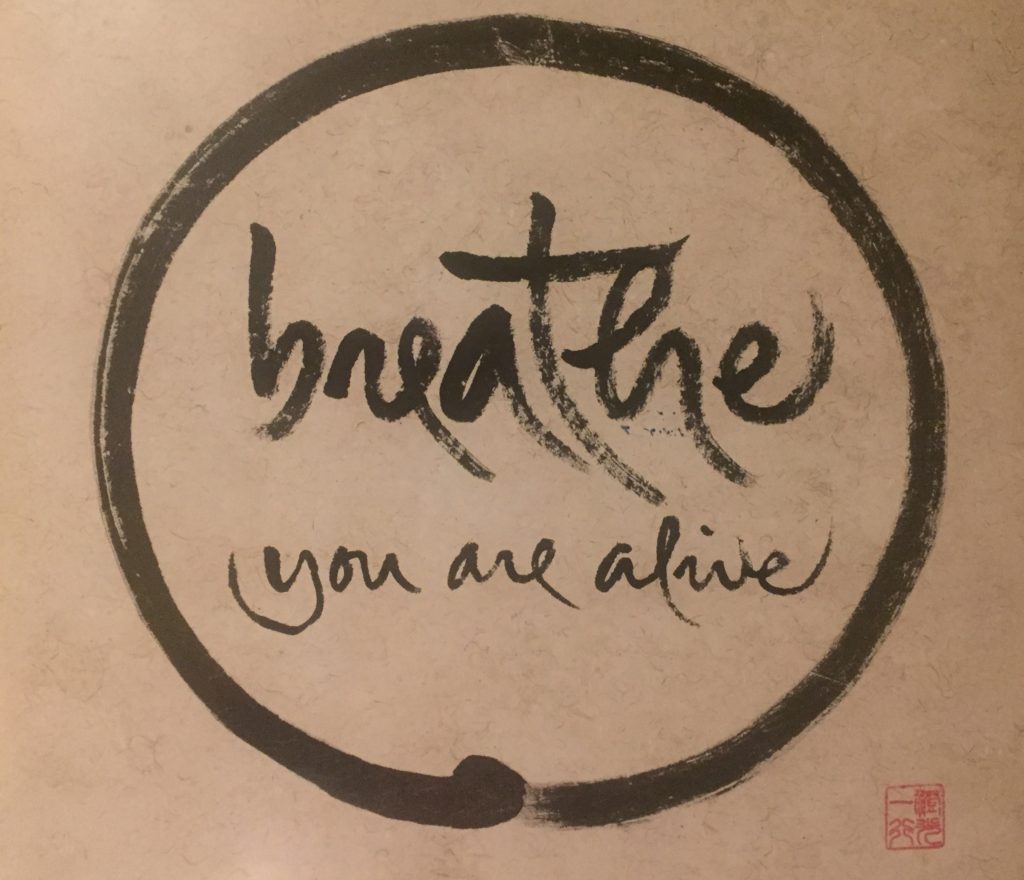
This month, my wall calendar has been telling me: “Breathe, you are alive.” This is a reminder to acknowledge and honour each breath, each moment of life. Each breath gives us life, sustaining our body and mind, allowing us to be and act in this world. By some mysterious will, some divine miracle, breath flows in and out of us, and we are alive!
This realization really dawned on me during a yoga nidra training I took last year. (In brief, yoga nidra – yogic sleep – refers to both a yogic practice and a state of being. As a practice, it is performed lying down, completely relaxing the body and breath, and guiding the mind through certain visualizations. This eventually leads to the state of yoga nidra, where body and mind are completely silent, and one’s awareness expands beyond body and mind.) During one of the practice sessions, the teacher, Rod Stryker, instructed us to let our breath become “effortless” – no effort to breathe, no effort to shape the breath in any way. It occurred to me then that I am not really breathing, but that my breath is happening to me. Life – or the Universe, or God – is breathing into me, keeping me alive.
Soon afterwards, I came across this quote, and it seemed to speak to the same idea:

This was a novel insight for me, especially given that so much of my yoga practice has involved breath control – shaping the inbreaths and outbreaths, and retaining the breath – the yogic practices of prānāyāma. I had unknowingly taken on the belief that I create my own breath.
But no, the breath is given to us, a gift from the Creator. In fact, we are given a certain number of breaths in our lifetime, according to ancient yogic teachings, and it is up to us how we spend those finite breaths. Is our breath typically short and quick? Do we rush through our breaths? Or do we learn to extend our breath, to use our breath wisely?
A yogi measures the span of life by the number of breaths, not by the number of years.
– Swami Sivananda, The Science of Pranayama
We have the potential to live long, healthy lives, and slowing down our breath is a big aide in this respect. It is said that if you breathe 15 times per minute, you will live to 75 or 80 years; if you breathe 10 times per minute you will live to 100 (Singh). Consider also that the longest-living animals have the slowest breath rates:
The restless monkey breathes at the rate of 32 times/minute, in contrast to man’s average, 18 times. The elephant, tortoise, snake and other animals noted for their longevity have a respiratory rate which is less than man’s. The tortoise, for instance, who may attain the age of 300 years, breathes only 4 times/minute.
– Paramahansa Yogananada, The Autobiography of a Yogi
Through prāṇāyāma, we can learn to slow the breath down, both during practice and in day-to-day life.
Prāṇāyāma is made up of two Sanskrit words: prāṇā, meaning life force, and ayāma meaning to extend or to control. Prāṇā is the energy that makes all things move, both in the body and in the Universe. Prāṇā animates what would otherwise be dull matter. It keeps our hearts beating, our blood flowing, our muscles and our organs working, our thoughts flowing, our emotions arising and subsiding. It is prāṇā too that keeps the planets moving in their orbits. Gravity, magnetism, electricity, sound, light, heat; these are all cosmic forms of prāṇā.
Prāṇāyāma generally refers to yogic breathing exercises. Through these exercises, we learn to control, to guide, to harness the power of our breath and our prāṇā. Simultaneously, we learn to harness the mind, as prāṇā and mind are inextricably linked:
If one controls the breath or Prana, the mind also is controlled. He who has controlled his mind has also controlled his breath. If one is suspended, the other is also suspended.
– Swami Sivananda, The Science of Pranayama
Have you ever noticed that when you are intensely focused on something (the mind still), your breath comes to a near standstill too?
There are many different kinds of prāṇāyāma. And there are many yogic approaches, aside from breathing exercises, to guide the prāṇā and the mind. But for now, let me share with you “Sivananda’s Pranayama”:
Technique: Sit comfortably on a chair, sofa or easy-chair. Draw the air through both nostrils, as long as comfortable. Retain as long as comfortable. Repeat your Ishta Mantra or ‘OM’ while retaining the breath. Then exhale as long as comfortable. You need not observe any ratio between the inhalation, exhalation and retention; but let the inhalation and exhalation be deep and full.
Benefit: The benefits of this Pranayama are incalculable. All the muscles are relaxed. All the nerves are toned. Rhythm and harmony are established in the entire being. Mind is calmed. Circulation is promoted. An inexpressible peace and bliss come to reign within you.– Swami Sivananda, The Science of Pranayama
You can do it in the morning while lying in bed. Your mind will become alert for commencing Japa [mantra repetition] and Dhyana [meditation]. You can do it when the mind is about to lose balance on account of the setting in of lust, anger or other evil Vrittis [thought forms]; the mind will be filled with a great power that will prevent the evil Vrittis from disturbing it. You can do it just before commencing your study; the mind will be concentrated easily and what you study will be indelibly impressed in your mind. You can do it during your office-work; you will get new strength every time and you will never be tired. When you return home from the office you can practise this Pranayama and you will be recharged with fresh energy. The greatest advantage is that once you start doing it you will do it very often; and your mind can never find an excuse for not practising this Ati-Sukha-Purvaka Pranayama, very easy and comfortable Pranayama, which has all the advantages of Pranayama, without its ‘rules and regulations’. Do it from now without fail.
References / Additional Reading:
David Frawley, “Understanding Prana”

breathtakingly powerful! Thank-You for the detailed encouraging overview and reminders!
I’m glad you enjoyed it! Thank You for the feedback 🙂